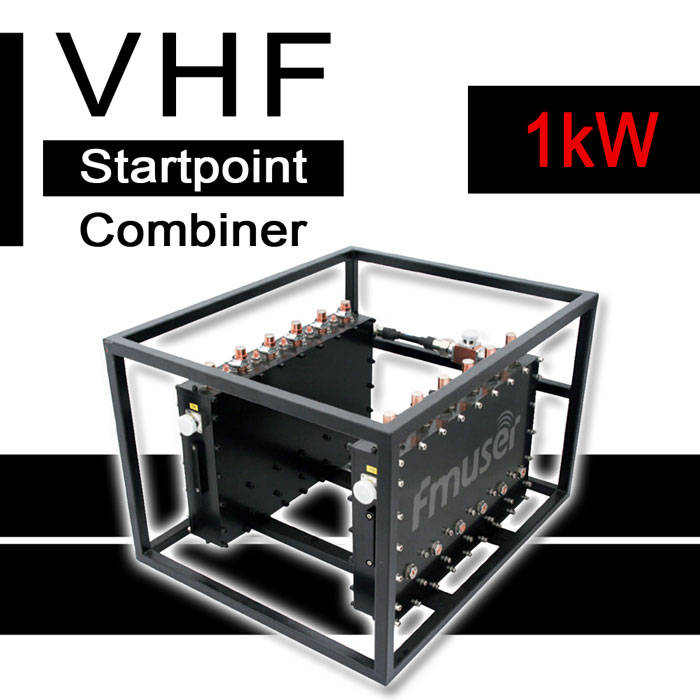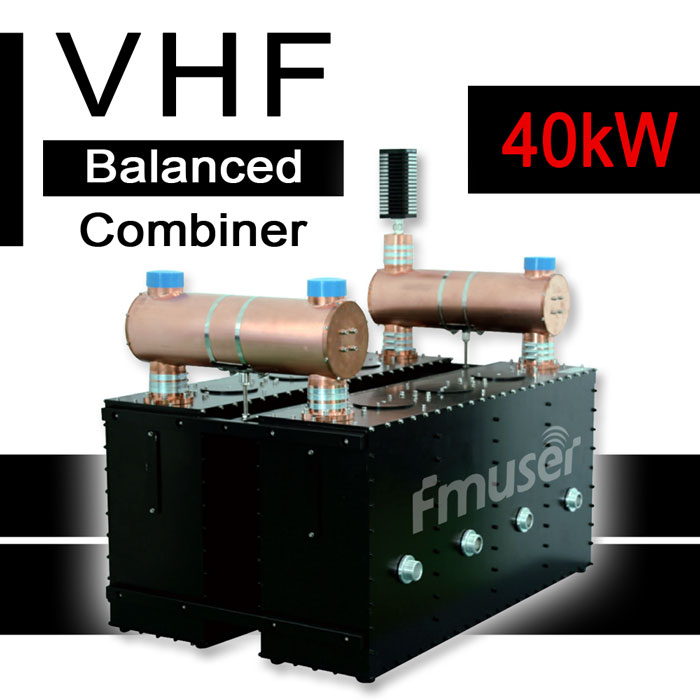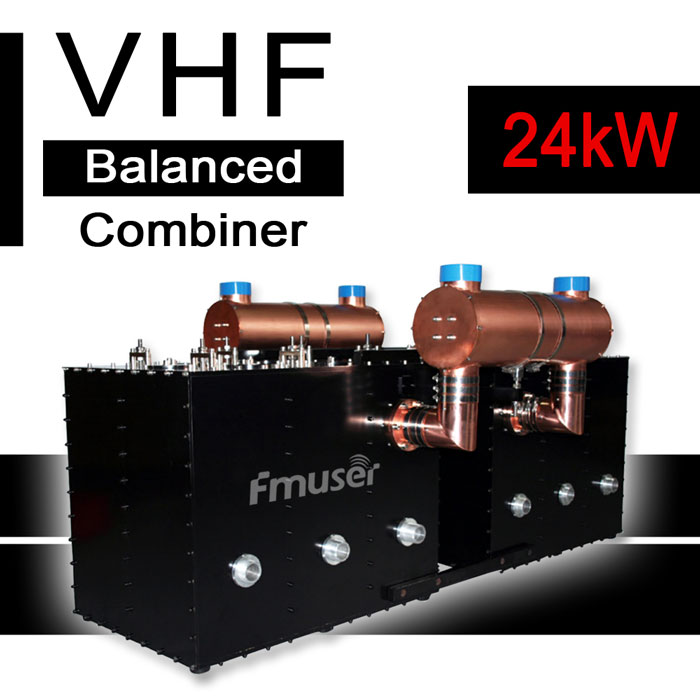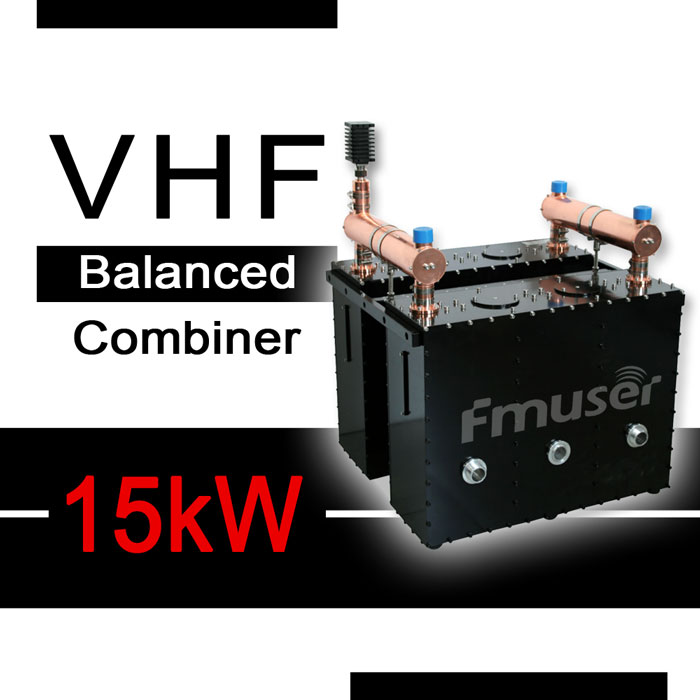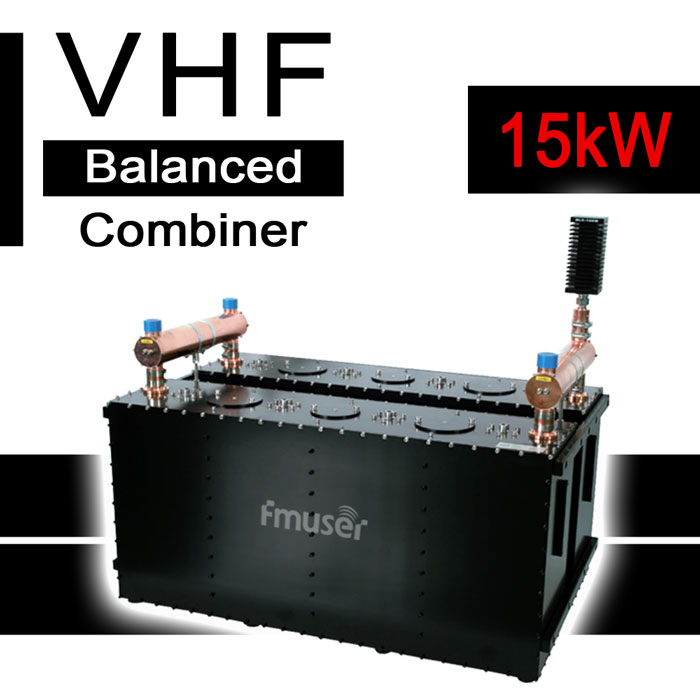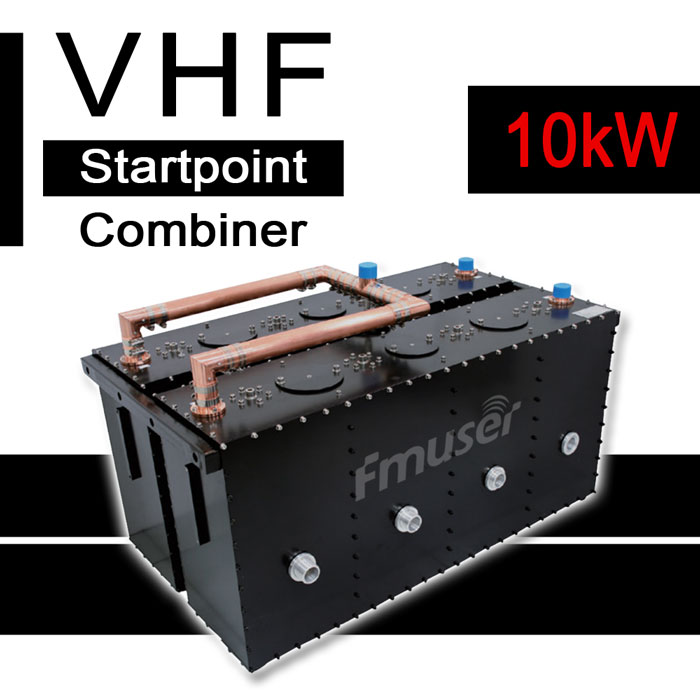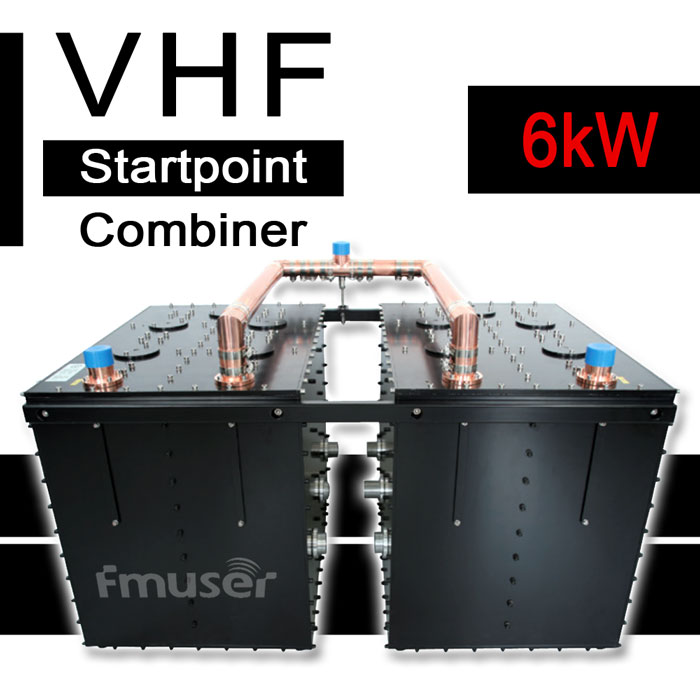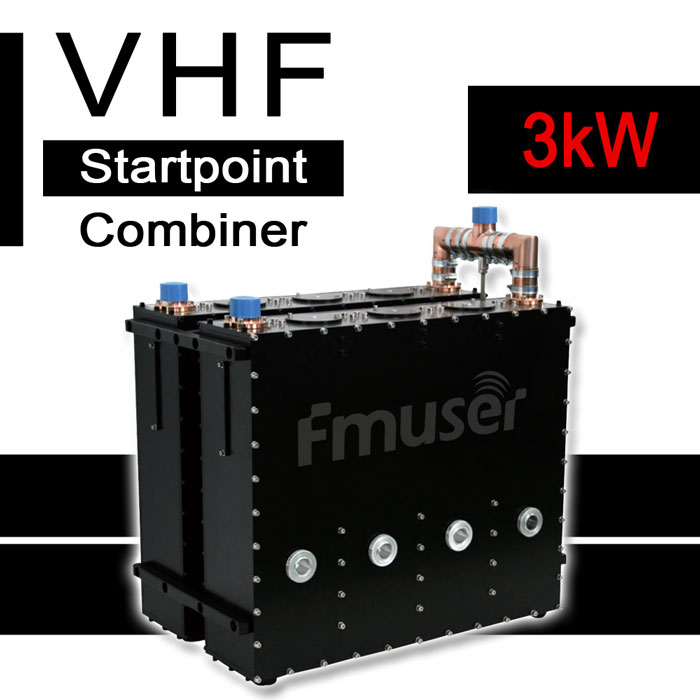
VHF Combiners
A VHF moxtjinżel (Wkoll magħruf as a VHF kavità moxtjinżel) is a apparat użati għal jikkombinaw multipli sinjali in l- ħafna għolja frekwenza (VHF) Firxa fis a wieħed sinjal. It is importanti għall xandir stazzjonijiet għaliex it tippermetti multipli jittrasmettureverse għal sehem l- istess antenna, li itejjeb sistema effiċjenza u, affidabbiltà. Din il is meħtieġ in sabiex għal Żieda sinjal saħħa u, itejbu kopertura żona.
-
![167-223 MHz 4 or 6 Cav. 7/16 DIN 1kW Starpoint VHF Transmitter Combiner Compact 6 Cavity Duplexer TX RX Duplexer for TV Station]()
Prezz (USD): Itlob għal kwotazzjoni
Mibjugħa: 3
-
![167-223 MHz 3 1/8" 3 or 4 Cav. 40kW Compact VHF TX RX Combiner Balanced VHF Cavity Duplexer 3 Way RF Combiner for TV Station]()
Prezz (USD): Itlob għal kwotazzjoni
Mibjugħa: 3
-
![167-223 MHz 3 1/8" 24kW Compact VHF 6 Cavity Duplexer Digital Balanced VHF Transmitter Combiner TX RX Duplexer for TV Broadcast]()
Prezz (USD): Itlob għal kwotazzjoni
Mibjugħa: 4
-
![167-223MHz 1 5/8" 3 or 4 Cavity 15kW VHF Transmitter Combiner Compact VHF Cavity Duplexer TX RX Balanced Duplexer for TV Station]()
Prezz (USD): Itlob għal kwotazzjoni
Mibjugħa: 9
-
![167-223 MHz 1 5/8" 3 or 4 Cav. 15kW Balanced VHF Transmitter Combiner Compact Radio Combiner VHF Cavity Duplexer for TV Station]()
Prezz (USD): Itlob għal kwotazzjoni
Mibjugħa: 4
-
![167-223 MHz 1 5/8" 4 Cav. VHF Starpoint 10kW Transmitter Combiner Compact Cavity Duplexer for VHF Combiner Multicoupler System]()
Prezz (USD): Itlob għal kwotazzjoni
Mibjugħa: 9
-
![167-223 MHz 4 or 6 Cav. 1 5/8" 6kW TX RX Combiner Compact 2 Way RF Combiner Starpoint VHF Duplexer Repeater for TV Station]()
Prezz (USD): kif
Mibjugħa: 6
-
![167-223 MHz 1 5/8" 4/6 Cav. 3kW VHF Starpoint Transmitter Combiner Compact Filter Combiner TX RX Systems Duplexer for TV Station]()
Prezz (USD): Itlob għal kwotazzjoni
Mibjugħa: 3
- Għal xiex jintuża VHF combiner?
- VHF combiners jintużaw biex jgħaqqdu trasmettituri u riċevituri multipli f'sistema ta 'antenna waħda. Dan jippermetti żieda fl-effiċjenza operattiva u l-iffrankar tal-ispejjeż. L-applikazzjonijiet l-aktar komuni ta 'combiners VHF jinkludu xandir, sigurtà pubblika u komunikazzjonijiet militari, u radju dilettanti.
- Kif tuża VHF combiner għax-xandir?
- 1. Kun żgur li l-antenni VHF kollha konnessi mal-combiner huma rranġati sew u f'kondizzjoni tajba.
2. Aġġusta bir-reqqa s-settings tal-gwadann tal-combiner biex jaqblu mal-output tal-antenni.
3. Tissorvelja l-output tal-combiner biex tiżgura li s-sinjali huma kkombinati sew u kwalunkwe interferenza tiġi eliminata.
4. Evita li tuża l-combiner f'żoni fejn hemm potenzjal għal interferenza qawwija, bħal qrib linja tal-enerġija.
5. Kun żgur li kwalunkwe komponenti addizzjonali huma konnessi sew, bħal amplifikaturi jew filtri.
6. Iċċekkja regolarment il-konnessjonijiet u s-settings tal-combiner biex tiżgura l-aħjar prestazzjoni.
- Kif jaħdem VHF combiner?
- VHF combiner huwa apparat użat fl-istazzjonijiet tax-xandir biex jgħaqqad sinjali multipli minn trasmettituri differenti f'output wieħed. Jaħdem billi jgħaqqad is-sinjali minn trasmettituri multipli f'sinjal wieħed, li mbagħad jixxandar minn antenna waħda komuni. Dan jgħin biex jitnaqqas in-numru ta 'antenni meħtieġa għax-xandir. Jgħin ukoll biex jitnaqqas l-ammont ta 'interferenza li jista' jseħħ minn sinjali multipli li qed jixxandru minn antenni multipli.
- Kemm hemm tipi ta' VHF combiners u x'inhuma d-differenzi bejniethom?
- Hemm tliet tipi ewlenin ta’ VHF combiners: passivi, ibridi u attivi. Il-kombinaturi VHF passivi huma l-aktar għażla sempliċi u l-inqas għalja, iżda jistgħu jintużaw biss meta s-sinjali kollha jkunu fl-istess livell ta 'qawwa. Il-kombinaturi VHF ibridi jistgħu jakkomodaw sinjali f'livelli ta 'enerġija differenti, iżda huma aktar ikkumplikati u għaljin minn kombinaturi passivi. Il-kombinaturi attivi tal-VHF jipprovdu l-ogħla livell ta 'prestazzjoni, iżda huma l-aktar għażla kumplessa u għalja.
- Kif tagħżel l-aħjar VHF combiner?
- Meta tagħżel l-aħjar VHF combiner għal stazzjon tax-xandir, huwa importanti li tikkunsidra ftit fatturi ewlenin. L-ewwelnett, ikkunsidra d-daqs u l-konfigurazzjoni tal-VHF combiner, biex tiżgura li taqbel mal-ispazju disponibbli u se tieħu ħsieb ir-rekwiżiti tal-qawwa u l-frekwenza tal-istazzjon. It-tieni nett, ikkunsidra l-kwalità tal-komponenti u l-materjali użati fil-prodott, biex tiżgura li se tolqot it-talbiet tal-istazzjon tax-xandir. Fl-aħħar iżda mhux l-inqas, ikkunsidra l-prezz tal-prodott, kif ukoll kwalunkwe garanzija jew garanzija offruta. Huwa wkoll importanti li taqra r-reviżjonijiet tal-klijenti biex ikollok idea aħjar ta 'kif il-prodott se jaħdem tajjeb.
- Kif tikkonnettja b'mod korrett VHF combiner fis-sistema tax-xandir?
- 1. Ibda billi tikkonnettja l-antenna mal-input tal-VHF combiner.
2. Qabbad l-output tal-combiner mat-trasmettitur.
3. Qabbad l-art tal-combiner mal-art tat-trasmettitur.
4. Kun żgur li l-konnessjonijiet kollha huma siguri u li l-combiner jitħaddem.
5. Ivverifika l-konnessjonijiet b'miter VSWR jew tagħmir ieħor tat-test xieraq.
6. Aġġusta l-amplitudnijiet tad-dħul u tal-ħruġ tal-combiner għal-livelli mixtieqa.
7. Tissorvelja l-prestazzjoni tal-combiner u t-trasmettitur biex tiżgura tħaddim tajjeb.
- Liema tagħmir huwa relatat ma' VHF combiner?
- It-tagħmir relatat ma 'combiner VHF fi stazzjon tax-xandir jinkludi: amplifikaturi tal-combiner, assemblaġġi tal-filtri, linji ta' trażmissjoni, couplers tal-antenna, couplers direzzjonali, u dividers tal-qawwa.
- X'inhuma l-aktar speċifikazzjonijiet fiżiċi u RF importanti ta' combiner VHF?
- L-aktar speċifikazzjonijiet fiżiċi u RF importanti għal combiner VHF jinkludu:
- Medda tal-Frekwenzi: Il-combiner tal-VHF għandu jkun kapaċi jaħdem fuq il-firxa tal-frekwenza VHF (30 MHz – 300 MHz).
- Telf ta 'inserzjoni: It-telf ta' inserzjoni għandu jkun baxx, tipikament inqas minn 0.5 dB.
- Telf tar-ritorn: It-telf tar-ritorn għandu jkun għoli, tipikament akbar minn 10 dB.
- Iżolament: L-iżolament bejn il-portijiet għandu jkun għoli, tipikament akbar minn 30 dB.
- VSWR: Il-VSWR għandu jkun baxx, tipikament inqas minn 1.5:1.
- Impedenza: L-impedenza għandha tkun 50 Ohms.
- Immaniġġjar tal-enerġija: L-immaniġġjar tal-enerġija għandu jkun biżżejjed għall-applikazzjoni.
- Kif inti żżomm korrettament combiner VHF bħala inġinier?
- Bħala inġinier, huwa importanti li twettaq manutenzjoni ta 'kuljum ta' VHF combiner fi stazzjon tax-xandir biex tiżgura l-aħjar prestazzjoni. Dan jinkludi l-ispezzjoni regolari tal-combiner għal kwalunkwe sinjal ta 'ħsara, l-iżgurar tal-konnessjonijiet kollha huma mwaħħla sew, il-verifika tal-komponenti kollha tal-ert, u t-tindif tal-combiner b'soluzzjoni tat-tindif approvata. Barra minn hekk, huwa importanti li jsiru testijiet regolari ta 'qligħ u telf biex jiġi żgurat li l-combiner qed jaħdem sew u biex jiċċekkja l-livell ta' intermodulazzjoni. Fl-aħħarnett, huwa importanti li tiċċekkja l-livelli tal-qawwa u tagħmel l-aġġustamenti meħtieġa.
- Kif isewwi VHF combiner jekk ma jkunx qed jaħdem?
- Biex isewwi VHF combiner, ser ikollok bżonn tidentifika l-partijiet miksura u mbagħad tibdilhom b'partijiet ġodda u kompatibbli. L-ewwel, kun żgur li l-enerġija hija mitfija u mbagħad uża multimeter biex tivverifika l-vultaġġ ta 'kull komponent. Jekk ikun aktar baxx mill-vultaġġ rakkomandat, allura jeħtieġ li jiġi sostitwit. Sussegwentement, uża ħadida tal-issaldjar biex tneħħi kwalunkwe partijiet miksura jew bil-ħsara. Imbagħad, ibdel il-partijiet miksura b'oħrajn ġodda. Ladarba l-partijiet il-ġodda jkunu f'posthom, issaldjahom flimkien u uża multimeter biex tivverifika li l-vultaġġ huwa korrett. Fl-aħħarnett, erġa għaqqad il-combiner u ttestjah biex tiżgura li qed taħdem sew. Jekk tonqos milli taħdem, jista 'jkollok bżonn tissostitwixxi partijiet addizzjonali.
- Kif tagħżel l-ippakkjar it-tajjeb għal combiner VHF?
- Meta tagħżel l-ippakkjar għal combiner VHF, kun żgur li tagħżel materjali li huma b'saħħithom u durabbli biżżejjed biex jipproteġu l-combiner minn kwalunkwe ħsara esterna. Barra minn hekk, kun żgur li tippakkja l-combiner b'mod li jipprevjeni kwalunkwe xokk jew vibrazzjoni waqt it-trasport. Huwa wkoll importanti li jiġi żgurat li l-imballaġġ ikun issiġillat sew biex jipprevjeni milli tidħol l-umdità. Fl-aħħar nett, kun żgur li ttikketta l-ippakkjar biex tiżgura li l-combiner ma jkunx espost għal xi temperaturi estremi waqt it-transitu.
- Liema materjal jintuża għall-kisi ta' VHF combiner?
- Il-kisi tal-combiner VHF huwa komunement magħmul minn metall, bħall-azzar jew l-aluminju. Dawn il-materjali mhux se jaffettwaw il-prestazzjoni tal-combiner, sakemm il-combiner ikun issiġillat sew biex jipprevjeni kwalunkwe umdità jew trab milli jidħol.
- X'inhi l-istruttura bażika ta' VHF combiner?
- L-istruttura bażika ta 'combiner VHF tipikament tikkonsisti f'duplexer, iżolatur, u filtru. Id-duplexer jippermetti li żewġ sinjali jiġu kkombinati jew maqsuma u jservi bħala l-port ta 'input/output għall-combiner. L-iżolatur jipprevjeni feedback u jiżola kull sinjal mill-ieħor, filwaqt li l-filtru jgħin biex jirrifjuta kwalunkwe sinjal mhux mixtieq. Il-prestazzjoni u l-attributi tal-combiner huma ddeterminati fil-biċċa l-kbira mill-kwalità tal-komponenti użati fil-kostruzzjoni tiegħu. Mingħajr l-ebda waħda minn dawn l-istrutturi, il-combiner ma jkunx jista 'jaħdem b'mod normali.
- Min għandu jiġi assenjat biex iħaddem VHF combiner?
- Il-persuna assenjata biex tmexxi l-VHF combiner għandha tkun xi ħadd li għandu esperjenza u għarfien dwar ix-xandir, il-frekwenzi tar-radju u t-trasmettituri. Din il-persuna għandu jkollha wkoll ħiliet eċċellenti biex issolvi l-problemi u għarfien tas-sistemi tal-antenni, kif ukoll il-kapaċità li ssolvi l-problemi u tiddijanjostika kwalunkwe kwistjoni teknika li tista 'tinqala'.
- Kif inti?
- jien tajjeb
IKKUNTATJANA


GRUPP INTERNAZZJONALI FMUSER LIMITED.
Aħna dejjem nipprovdu lill-klijenti tagħna prodotti affidabbli u servizzi meqjusa.
Jekk tixtieq iżżomm kuntatt magħna direttament, jekk jogħġbok mur fuq Ikkuntatjana
